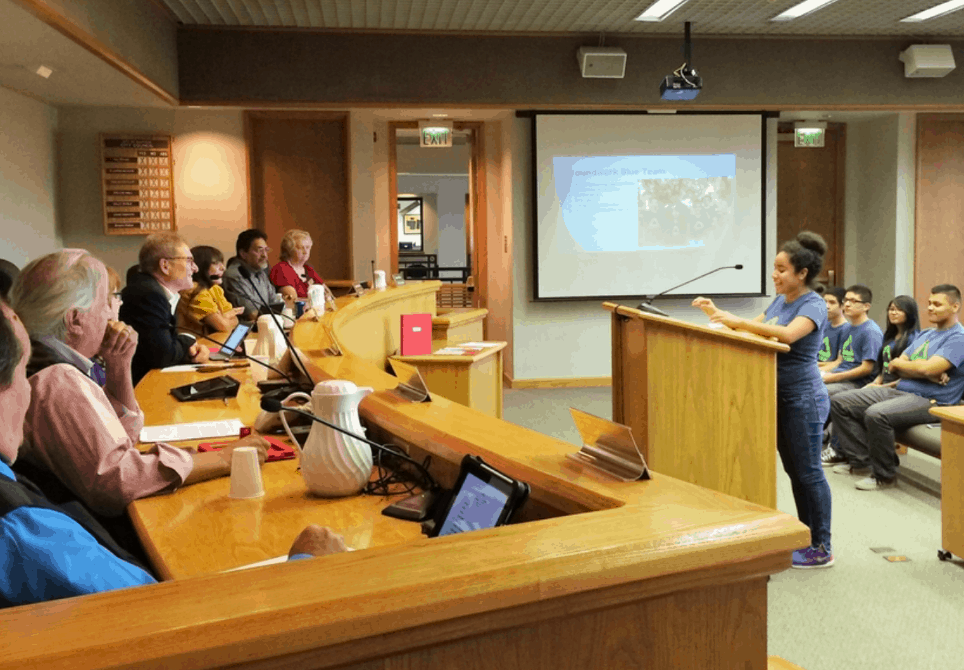Developing a Sense of Place Means a Deeper Connection to Learning

By Kristen Mueller-Sims
The unknown environmental challenges that will confront us in the future will require the commitment and ingenuity of all of us, and it is critical that we are preparing youth to take on this role.
At Earth Force, we believe that developing a deep sense of place in young people leads to a citizenry that is prepared and willing to contribute to communities for a lifetime.
The Community Action & Problem-Solving Process
Students use our Community Action and Problem-Solving Process, a six-step model that combines the best of civic engagement, environmental education and STEM. Youth work together to design and implement a project to explore root causes and address a policy or practice related to the environmental issue that they identify in their community.
Earth Force’s focus on civic engagement helps learners to become active participants in their communities by conducting balanced research, building strong community partnerships and making decisions as a democratic group.

We provide professional development around the Process for our partners and for formal and informal educators so they have the skills to take learning beyond the classroom walls and into the community.
We approach place-based education by developing skills, knowledge and motivation. And we know it works.
Over 15 years of evaluation shows that Earth Force students gain civic skills, have a stronger understanding of the environment and how they can impact change and want to continue to solve environmental issues in the community. A key piece of this work is encouraging students to identify issues that directly affect them at a local level. This creates buy-in and a deeper sense of purpose when working to find a solution.
STEM Knowledge
Students improve their STEM knowledge by generating and applying data to address issues in their community. For example, students at Annunciation K-8 analyzed water samples from the South Platte River to determine nutrient content, levels of dissolved oxygen, and the percentage of animal waste in the water. Students then used math equations to calculate the perimeter and area of their schoolyard, which is near the river, to determine the ratio of concrete to grass, and to calculate how much water the site can absorb.
By developing knowledge and applying it to real-world issues in their local communities, students build an understanding of how to participate as active citizens. Communities create an engaged populace that is able to attain and understand knowledge and use it to make positive improvements in their community.
Civic Skills
Earth Force students develop civic skills by working with their communities to solve local problems. To solve problems, Earth Force students apply civic skills like problem-solving, critical-thinking and teamwork to influence how schools and communities address community problems.
Students in Albuquerque used their water quality data to argue that the stormwater system in low-income neighborhoods is poorly designed and needed improvement. They are working with the U.S. Fish and Wildlife Service to incorporate their environmental justice findings into local land management plans.
Examples like this show the importance of developing civic skills with a sense of place. It teaches students how to interact with key stakeholders to create change, as well as resiliency when working to solve complex problems. 90% of participating students improve their problem-solving, decision-making, and critical thinking skills.
Environmental Motivation
Earth Force gives young people hands-on experience solving environmental problems, which motivates them to become lifelong advocates for the environment and their community. Each year thousands of Earth Force students complete projects that improve their local environment. Many of them continue that work beyond the classroom.
For instance, Ana Humphrey started a program to protect wetlands in 7th grade and now runs her own environmental program at her high school that reaches five elementary schools. After gaining the knowledge and the skills necessary to create change and being supported in taking action to address an issue they identified in their community, 78% of students want to continue protecting the environment.
Creating A Sense of Place for a Lifetime
By developing knowledge, skills and motivation, Earth Force young people are becoming more deeply invested in their community. They have the tools to understand the complexities of their surroundings and the confidence to be active participants and decision-makers.
By connecting young people’s learning to a sense of place today, we are creating stronger communities for tomorrow.
This blog is part of our “Place-Based Education” blog series. To learn more and contribute a guest post for the series, check out the PBE campaign page. Join in the conversation on social media using #PlaceBasedEd. For more on Place-Based Education see:
- Four Ways Students Learn from School Gardens
- Expanding & Enriching Relationships in Place-Based Ed
- Place-Based Education: Communities As Learning Environments
Kristen Mueller-Sims is Director of Communications at Earth Force. Follow them on Twitter: @earthforce
Stay in-the-know with all things EdTech and innovations in learning by signing up to receive the weekly Smart Update.





0 Comments
Leave a Comment
Your email address will not be published. All fields are required.